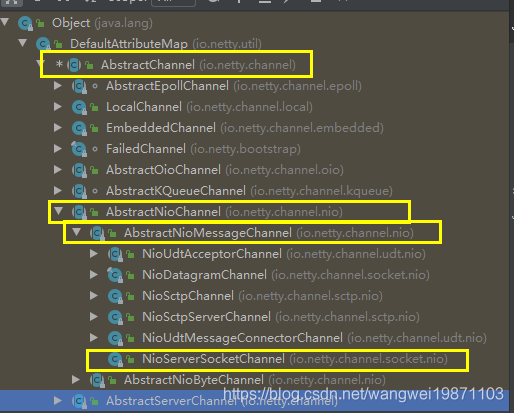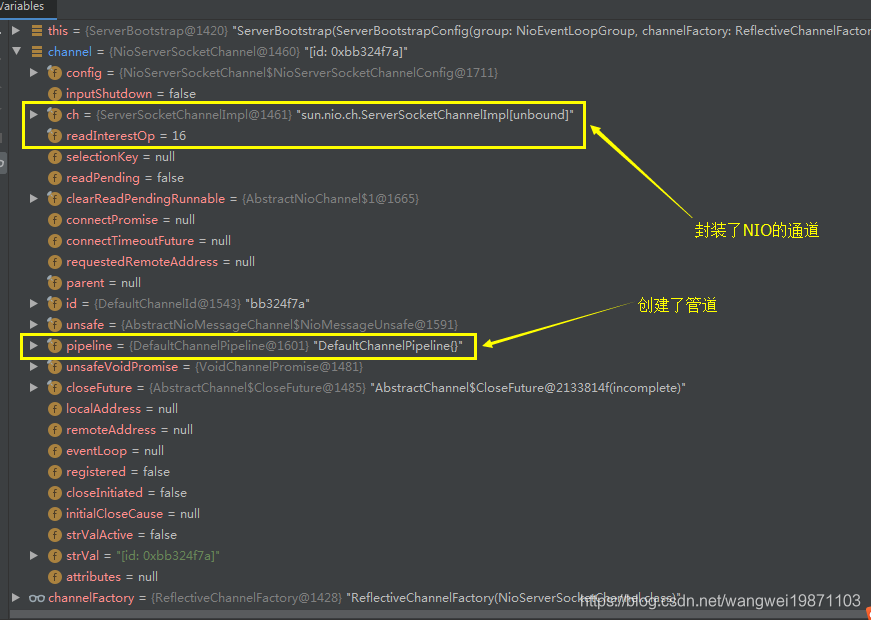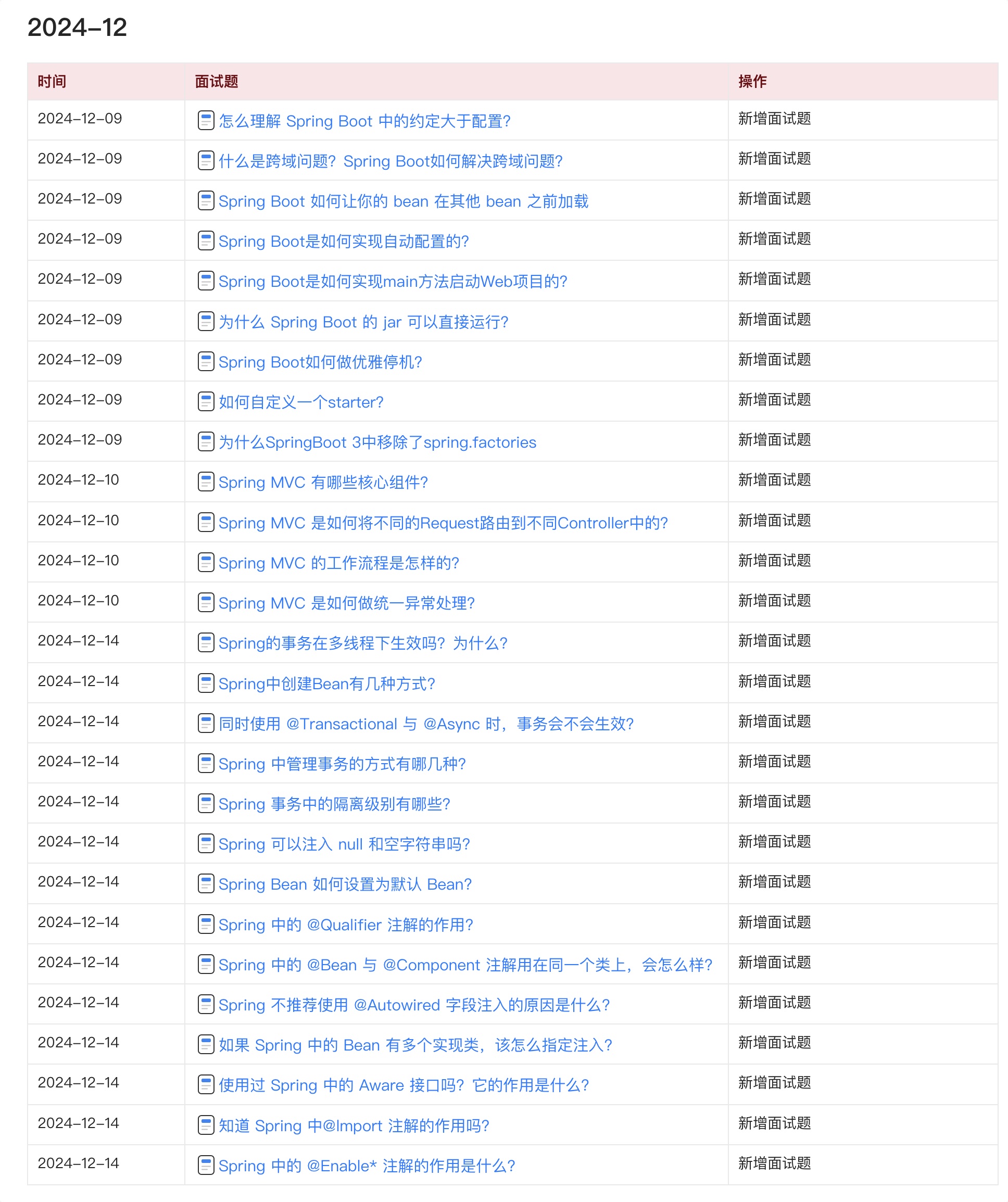启动器ServerBootstrap
继续上次的例子,上次已经创建了bossGroup和workerGroup,接下去就是创建启动器了。我们先看看这个结构图:

可以看到他的父类其实和他基本平分一般属性的设置。其实构造方法没做什么,只是初始化了一些属性和选项的集合和ServerBootstrapConfig实例。
然后设置两个group就把上图的两个Group设置了一下:
bootstrap.group(bossGroup, workerGroup)
这个channel(NioServerSocketChannel.class)就有讲究了,一看传的是个Class对象,应该能想到要反射了。看源码:
public B channel(Class<? extends C> channelClass) {
return channelFactory(new ReflectiveChannelFactory<C>(
ObjectUtil.checkNotNull(channelClass, "channelClass")
));
}
有创建反射通道工厂new ReflectiveChannelFactory,就是通过反射获得无参构造函数this.constructor,当调用newChannel()的时候就可以创建对象了,看下ReflectiveChannelFactory这个类:
public class ReflectiveChannelFactory<T extends Channel> implements ChannelFactory<T> {
//取得构造函数后面直接创建实例
private final Constructor<? extends T> constructor;
public ReflectiveChannelFactory(Class<? extends T> clazz) {
ObjectUtil.checkNotNull(clazz, "clazz");
try {
this.constructor = clazz.getConstructor();//无参构造函数
} catch (NoSuchMethodException e) {
throw new IllegalArgumentException("Class " + StringUtil.simpleClassName(clazz) +
" does not have a public non-arg constructor", e);
}
}
@Override
public T newChannel() {
try {
return constructor.newInstance();
} catch (Throwable t) {
throw new ChannelException("Unable to create Channel from class " + constructor.getDeclaringClass(), t);
}
}
@Override
public String toString() {
return StringUtil.simpleClassName(ReflectiveChannelFactory.class) +
'(' + StringUtil.simpleClassName(constructor.getDeclaringClass()) + ".class)";
}
}
一目了然了,继续channelFactory方法,就是设置通道工厂,返回自身,继续链式调用:
public B channelFactory(io.netty.channel.ChannelFactory<? extends C> channelFactory) {
return channelFactory((ChannelFactory<C>) channelFactory);
}
public B channelFactory(ChannelFactory<? extends C> channelFactory) {
ObjectUtil.checkNotNull(channelFactory, "channelFactory");
if (this.channelFactory != null) {
throw new IllegalStateException("channelFactory set already");
}
this.channelFactory = channelFactory;
return self();
}
然后我们继续childHandler(ChannelHandler childHandler) ,其实也就设置childHandler ,这个时候设置的其实就是通道的初始化ChannelInitializer:
public ServerBootstrap childHandler(ChannelHandler childHandler) {
this.childHandler = ObjectUtil.checkNotNull(childHandler, "childHandler");
return this;
}
关键的bind
我先来个图吧,可以先看下关键的流程,有个大概,然后下面慢慢分析:

关键的方法来了ChannelFuture cf = bootstrap.bind(8888).sync();:
public ChannelFuture bind(int inetPort) {
return bind(new InetSocketAddress(inetPort));
}
public ChannelFuture bind(SocketAddress localAddress) {
validate();
return doBind(ObjectUtil.checkNotNull(localAddress, "localAddress"));
}
doBind
这里做了好多事啊,我们慢慢分析:
private ChannelFuture doBind(final SocketAddress localAddress) {
final ChannelFuture regFuture = initAndRegister();//通道的创建和初始化initAndRegister
final Channel channel = regFuture.channel();
if (regFuture.cause() != null) {
return regFuture;
}
if (regFuture.isDone()) {
// At this point we know that the registration was complete and successful.
ChannelPromise promise = channel.newPromise();
doBind0(regFuture, channel, localAddress, promise);
return promise;
} else {
// Registration future is almost always fulfilled already, but just in case it's not.
final PendingRegistrationPromise promise = new PendingRegistrationPromise(channel);
regFuture.addListener(new ChannelFutureListener() {
@Override
public void operationComplete(ChannelFuture future) throws Exception {
Throwable cause = future.cause();
if (cause != null) {
// Registration on the EventLoop failed so fail the ChannelPromise directly to not cause an
// IllegalStateException once we try to access the EventLoop of the Channel.
promise.setFailure(cause);
} else {
// Registration was successful, so set the correct executor to use.
// See https://github.com/netty/netty/issues/2586
promise.registered();
doBind0(regFuture, channel, localAddress, promise);
}
}
});
return promise;
}
}
通道的创建和初始化initAndRegister
final ChannelFuture initAndRegister() {
Channel channel = null;
try {
channel = channelFactory.newChannel();//创建通道
init(channel);//初始化通道
} catch (Throwable t) {
...
}
ChannelFuture regFuture = config().group().register(channel);
if (regFuture.cause() != null) {
if (channel.isRegistered()) {
channel.close();
} else {
channel.unsafe().closeForcibly();
}
}
return regFuture;
}
这里的channelFactory.newChannel();就是创建上面讲的设置channel(NioServerSocketChannel.class)的NioServerSocketChannel实例:

实例化NioServerSocketChannel
看看这个的简单结构,黄色的框里的都是会调用到构造函数的:

我们来看看NioServerSocketChannel的实例化:
public NioServerSocketChannel() {
this(newSocket(DEFAULT_SELECTOR_PROVIDER));
}
private static ServerSocketChannel newSocket(SelectorProvider provider) {
try {
return provider.openServerSocketChannel();
} catch (IOException e) {
throw new ChannelException(
"Failed to open a server socket.", e);
}
}
newSocket返回的是默认的ServerSocketChannelImpl,这个是NIO里的。
然后继续构造函数,可以看到 SelectionKey.OP_ACCEPT,这个不就是NIO里的请求连接么:
public NioServerSocketChannel(ServerSocketChannel channel) {
super(null, channel, SelectionKey.OP_ACCEPT);
config = new NioServerSocketChannelConfig(this, javaChannel().socket());
}
这里设置了一些配置信息,通道NioServerSocketChannel和一个ServerSocket实例。
super的:
protected AbstractNioMessageChannel(Channel parent, SelectableChannel ch, int readInterestOp) {
super(parent, ch, readInterestOp);
}
super的:
protected AbstractNioChannel(Channel parent, SelectableChannel ch, int readInterestOp) {
super(parent);
this.ch = ch;//设置ServerSocketChannel实例ServerSocketChannelImpl
this.readInterestOp = readInterestOp;//设置事件OP_ACCEPT
try {
ch.configureBlocking(false);//设置非阻塞
} catch (IOException e) {
...
}
}
这里设置了通道NioServerSocketChannel和感兴趣的事件readInterestOp。
最后super的:
protected AbstractChannel(Channel parent) {
this.parent = parent;
id = newId();//id
unsafe = newUnsafe();//创建NioMessageUnsafe,一些底层的操作都是这个来完成的
pipeline = newChannelPipeline();//管道
}
看到最后一个里面有pipeline = newChannelPipeline();,创建了ChannelPipeline类型的实例,实际类型是DefaultChannelPipeline,还创建了id 类型是DefaultChannelId实现了ChannelId,也就是可以生成唯一标识符asLongText()的实例。
DefaultChannelPipeline
这里就稍微介绍下这个吧,后面还会重点介绍ChannelPipeline,看这个的构造函数:
protected DefaultChannelPipeline(Channel channel) {
this.channel = ObjectUtil.checkNotNull(channel, "channel");
succeededFuture = new SucceededChannelFuture(channel, null);
voidPromise = new VoidChannelPromise(channel, true);
tail = new TailContext(this);
head = new HeadContext(this);
head.next = tail;
tail.prev = head;
}
可以看到双向链表的结构,头尾都是初始化好的:

我们可以看看创建完的NioServerSocketChannel:

初始化通道init(channel)
@Override
void init(Channel channel) {
setChannelOptions(channel, options0().entrySet().toArray(EMPTY_OPTION_ARRAY), logger);
setAttributes(channel, attrs0().entrySet().toArray(EMPTY_ATTRIBUTE_ARRAY));
ChannelPipeline p = channel.pipeline();
final EventLoopGroup currentChildGroup = childGroup;
final ChannelHandler currentChildHandler = childHandler;
final Entry<ChannelOption<?>, Object>[] currentChildOptions =
childOptions.entrySet().toArray(EMPTY_OPTION_ARRAY);
final Entry<AttributeKey<?>, Object>[] currentChildAttrs = childAttrs.entrySet().toArray(EMPTY_ATTRIBUTE_ARRAY);
p.addLast(new ChannelInitializer<Channel>() {
@Override
public void initChannel(final Channel ch) {
final ChannelPipeline pipeline = ch.pipeline();
ChannelHandler handler = config.handler();
if (handler != null) {
pipeline.addLast(handler);
}
ch.eventLoop().execute(new Runnable() {
@Override
public void run() {
pipeline.addLast(new ServerBootstrapAcceptor(
ch, currentChildGroup, currentChildHandler, currentChildOptions, currentChildAttrs));
}
});
}
});
}
关键点addLast
前面设置一堆属性,最后的在管道的倒数第二个位置上加了一个ChannelInitializer,我为什么说addLast是导数第二个位置,而不是加到最后呢,来看看源码:
@Override
public final ChannelPipeline addLast(ChannelHandler... handlers) {
return addLast(null, handlers);
}
@Override
public final ChannelPipeline addLast(EventExecutorGroup executor, ChannelHandler... handlers) {
ObjectUtil.checkNotNull(handlers, "handlers");
for (ChannelHandler h: handlers) {
if (h == null) {
break;
}
addLast(executor, null, h);
}
return this;
}
具体的还在这里:
public final ChannelPipeline addLast(EventExecutorGroup group, String name, ChannelHandler handler) {
final AbstractChannelHandlerContext newCtx;
synchronized (this) {
checkMultiplicity(handler);
newCtx = newContext(group, filterName(name, handler), handler);
addLast0(newCtx);
if (!registered) {//只会执行一次
newCtx.setAddPending();
callHandlerCallbackLater(newCtx, true);//暂时放入一个单链表中后面执行
return this;
}
EventExecutor executor = newCtx.executor();
if (!executor.inEventLoop()) {
callHandlerAddedInEventLoop(newCtx, executor);
return this;
}
}
callHandlerAdded0(newCtx);
return this;
}
创建ChannelHandlerContext实例newContext
会创建DefaultChannelHandlerContext实例,是ChannelHandlerContext的子类,而且会把管道和handler传进去,所以为什么ChannelHandlerContext可以获得管道和处理器了,具体的细节暂时不讲,后面一起讲:
private AbstractChannelHandlerContext newContext(EventExecutorGroup group, String name, ChannelHandler handler) {
return new DefaultChannelHandlerContext(this, childExecutor(group), name, handler);
}

不是增加到尾部的addLast0
我们可以看到,这个就是把前面创建的ChannelHandlerContext加到里面去了,可见处理器被通道处理器上下文给包裹了,我们看他是怎么添加的,他只是把新的结点插入到导数第二个位置:
private void addLast0(AbstractChannelHandlerContext newCtx) {
AbstractChannelHandlerContext prev = tail.prev;
newCtx.prev = prev;
newCtx.next = tail;
prev.next = newCtx;
tail.prev = newCtx;
}
图示:

之后因为是第一次注册,所以就会返回了:
if (!registered) {
newCtx.setAddPending();
callHandlerCallbackLater(newCtx, true);//暂时放入一个单链表中后面执行
return this;
}
我们再看看初始化的处理器做了什么:
public void initChannel(final Channel ch) {
final ChannelPipeline pipeline = ch.pipeline();
ChannelHandler handler = config.handler();
if (handler != null) {//如果有设置handler ,把handler 也加上
pipeline.addLast(handler);
}
ch.eventLoop().execute(new Runnable() {
@Override
public void run() {
pipeline.addLast(new ServerBootstrapAcceptor(
ch, currentChildGroup, currentChildHandler, currentChildOptions, currentChildAttrs));
}
});
}
主要就是开启一个循环把ServerBootstrapAcceptor加到了通道里去了,这个也就是我们常说的连接接收器Acceptor。那什么时候这段代码会执行呢,后面我们会讲,这里先不展开。接下去的东西后面讲吧,跟了源码太多,就太长了,不跟源码讲的太粗粒度又没啥意思,还是平衡下吧。
好了,今天就到这里了,希望对学习理解有帮助,大神看见勿喷,仅为自己的学习理解,能力有限,请多包涵。
Java 面试宝典是大明哥全力打造的 Java 精品面试题,它是一份靠谱、强大、详细、经典的 Java 后端面试宝典。它不仅仅只是一道道面试题,而是一套完整的 Java 知识体系,一套你 Java 知识点的扫盲贴。
它的内容包括:
- 大厂真题:Java 面试宝典里面的题目都是最近几年的高频的大厂面试真题。
- 原创内容:Java 面试宝典内容全部都是大明哥原创,内容全面且通俗易懂,回答部分可以直接作为面试回答内容。
- 持续更新:一次购买,永久有效。大明哥会持续更新 3+ 年,累计更新 1000+,宝典会不断迭代更新,保证最新、最全面。
- 覆盖全面:本宝典累计更新 1000+,从 Java 入门到 Java 架构的高频面试题,实现 360° 全覆盖。
- 不止面试:内容包含面试题解析、内容详解、知识扩展,它不仅仅只是一份面试题,更是一套完整的 Java 知识体系。
- 宝典详情:https://www.yuque.com/chenssy/sike-java/xvlo920axlp7sf4k
- 宝典总览:https://www.yuque.com/chenssy/sike-java/yogsehzntzgp4ly1
- 宝典进展:https://www.yuque.com/chenssy/sike-java/en9ned7loo47z5aw
目前 Java 面试宝典累计更新 400+ 道,总字数 42w+。大明哥还在持续更新中,下图是大明哥在 2024-12 月份的更新情况:

想了解详情的小伙伴,扫描下面二维码加大明哥微信【daming091】咨询

同时,大明哥也整理一套目前市面最常见的热点面试题。微信搜[大明哥聊 Java]或扫描下方二维码关注大明哥的原创公众号[大明哥聊 Java] ,回复【面试题】 即可免费领取。

